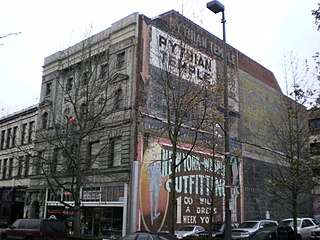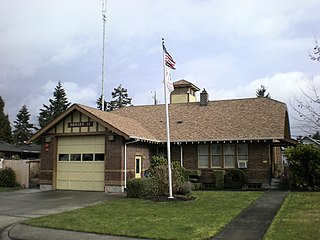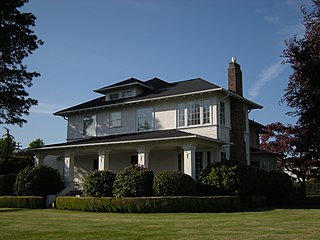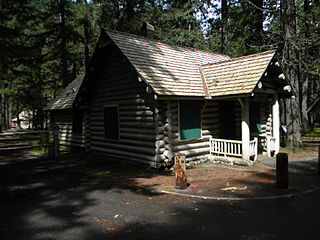
State Route 410 is a 107.44-mile (172.91 km) long state highway that traverses Pierce, King, and Yakima counties in the US state of Washington. It begins at an interchange with SR 167 in Sumner and travels southeast across the Cascade Range to a junction with U.S. Route 12 (US 12) in Naches. While the western part of SR 410 is a freeway that serves built-up, urban areas, the remainder of the route is a surface road that traverses mostly rural areas as it passes through the mountains.

The William Ross Rust House is a house in Tacoma, Washington, United States, built in 1905 for William Ross Rust, then President of the Tacoma Smelter and Refining Company. The same year the Tacoma Smelter was acquired by ASARCO which was controlled by the Guggenheim family. The house was designed by Ambrose J. Russell, who worked for Russell & Babcock with Everett Phipps Babcock, and was built by Charles Miller. Russell & Babcock also designed the Washington Governor's Mansion.

Engine House No. 9 in Tacoma, Washington, is a fire station built in 1907. The building was placed on the National Register of Historic Places in 1975.

The Pythian Temple, built in 1906 for Commencement Lodge Number 7 of the Knights of Pythias, is an historic building located on Broadway in the Theater District of Tacoma, Washington. It was designed by noted Tacoma architect Frederick Heath.

The Luzon Building was a historic six-story building at 1302 Pacific Avenue in downtown Tacoma, Washington designed by Chicago architects Daniel Burnham and John Root.

Frederick Heath was an American architect responsible for numerous projects in Tacoma, Washington. He worked out of his own office and as a senior partner at architectural firms. He was involved with Spaulding, Russell & Heath, and Heath & Gove. His work included designs for several historic and notable schools, churches, stadiums, and commercial properties.

The Elks Temple in Tacoma, Washington is a historic Beaux Arts Fraternal building built in 1916 for the Fraternal Order of Elks, now housing the McMenamins Elks Temple hotel, restaurant and event space.

The Union Passenger Station in Tacoma, Washington, United States, opened in 1911. It was listed on the National Register of Historic Places in 1974. It now serves as a courthouse of the United States District Court for the Western District of Washington. The distinctive architecture, dominated by a copper dome, is a landmark for the area.

The Community Center and War Memorial Building is a building located in Everett, Washington listed on the National Register of Historic Places. Built by the Knights of Columbus in 1921, it was designed by Tacoma architects Charles Lundberg and C. Frank Mahon.

Fire Station No. 2 is a fire station located at 2701 S Tacoma Avenue in Tacoma, Washington. The Art Deco building was designed by architect Salas E. Nelson and built by Knoell Brothers in 1907. It was listed on the National Register of Historic Places on May 2, 1986 as part of the thematic resource, "Historic Fire Stations of Tacoma, Washington".

Fire Station No. 5 is a fire station located in Tacoma, Washington listed on the National Register of Historic Places. It is currently still in active service, but was renamed Fire Station 4 when Tacoma's former Station 4 at 222 E 26th Street was closed.

Fire Station No. 15 is a fire station located in Tacoma, Washington listed on the National Register of Historic Places. It was designed by Tacoma architect, M. J. Nicholson, in 1928.

Fire Station No. 10 is a fire station located at 7247 S Park Avenue in Tacoma, Washington. The station was designed by architect Morton J. Nicholson and built by Martin H. Marker in 1928. It was listed on the National Register of Historic Places on May 2, 1986, as part of a thematic resource, "Historic Fire Stations of Tacoma, Washington".

The National Bank of Tacoma Building, also known as the National Bank of Washington and as the Tacoma Art Museum, is a former bank building in downtown Tacoma, Washington, United States. It was designed by Sutton & Whitney and built in 1921. It was listed on the National Register of Historic Places in 2006.

The Louis and Ellen Olson House, a Craftsman style mansion built in 1903, is located near downtown Enumclaw, Washington, United States. It has been listed on the National Register of Historic Places since 1984. The mansion is currently a private residence.

St. Peter's Church is a historic church on Starr between 29th and 30th Streets in the Old Tacoma neighborhood of Tacoma, Washington, United States.

The Engine House No. 4 in Tacoma, Washington, at 220-224 E. 26th St., was built in 1911. It was listed on the National Register of Historic Places in 1984.

Enumclaw is an American indie rock band from Tacoma, Washington. The band is named after the city of Enumclaw, Washington. In February 2022, the band was signed to Luminelle Recordings, an imprint of Fat Possum Records. On October 14, 2022, Enumclaw released their debut studio album, Save The Baby. The band embarked on their first European tour in May 2023, making stops in 15 cities.

The buildings of the Silver Creek Ranger Station typify Civilian Conservation Corps (CCC) and Economic Recovery Act (ERA). These relief programs employed local youth and experienced craftsmen. Building materials and camp supplies were obtained locally. The U.S. Forest Service's was the host agency and the facility was the headquarters for field operation The design of the buildings is an example of the rustic architectural style used by the Forest Service. Building 1362 is rare. Only three log Depression-era offices are known in the Pacific Northwest Region.




















